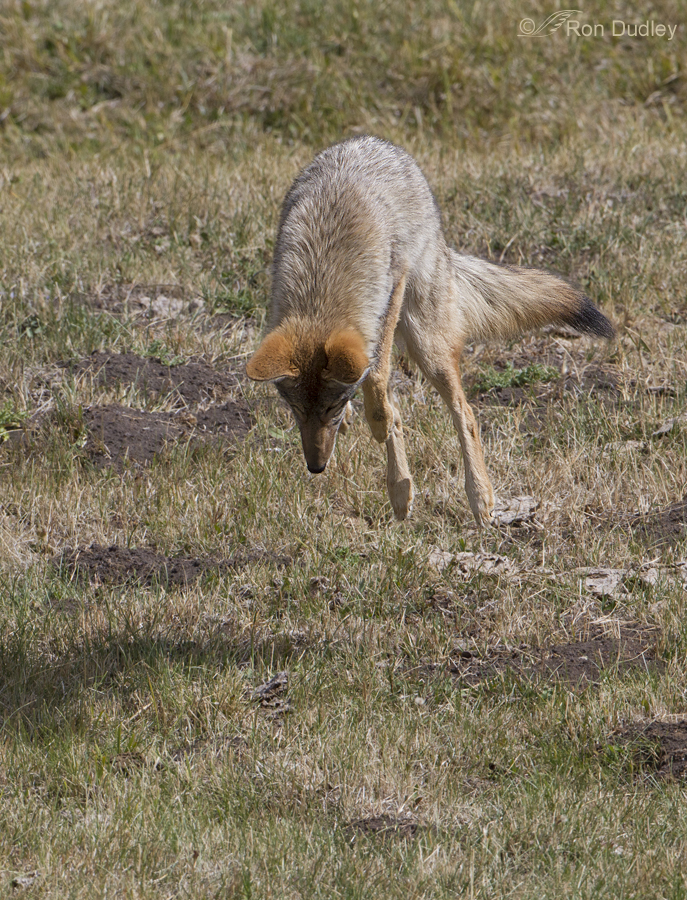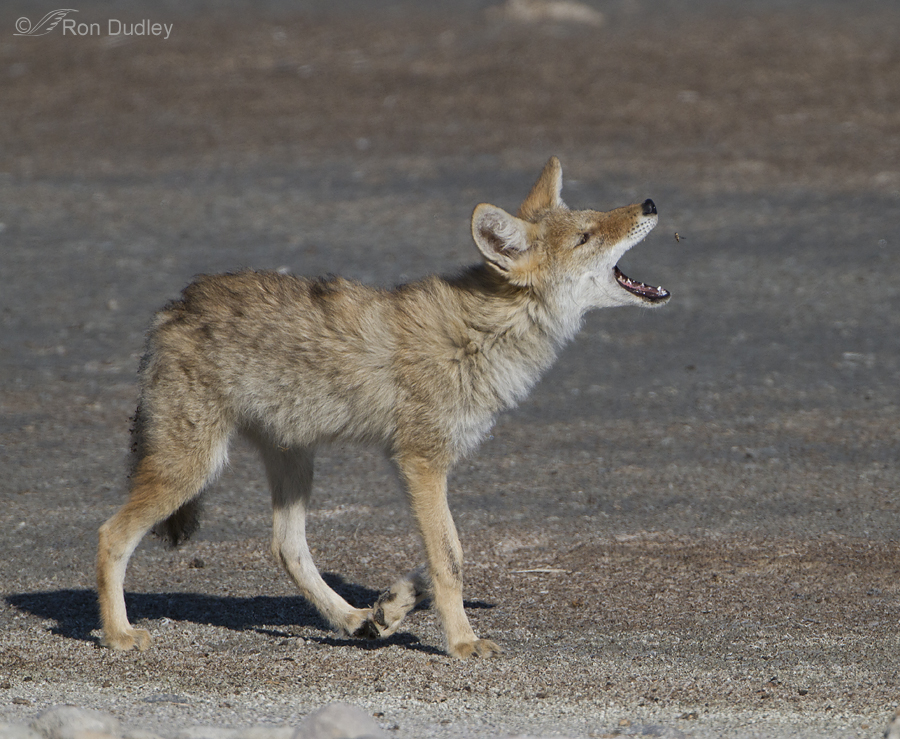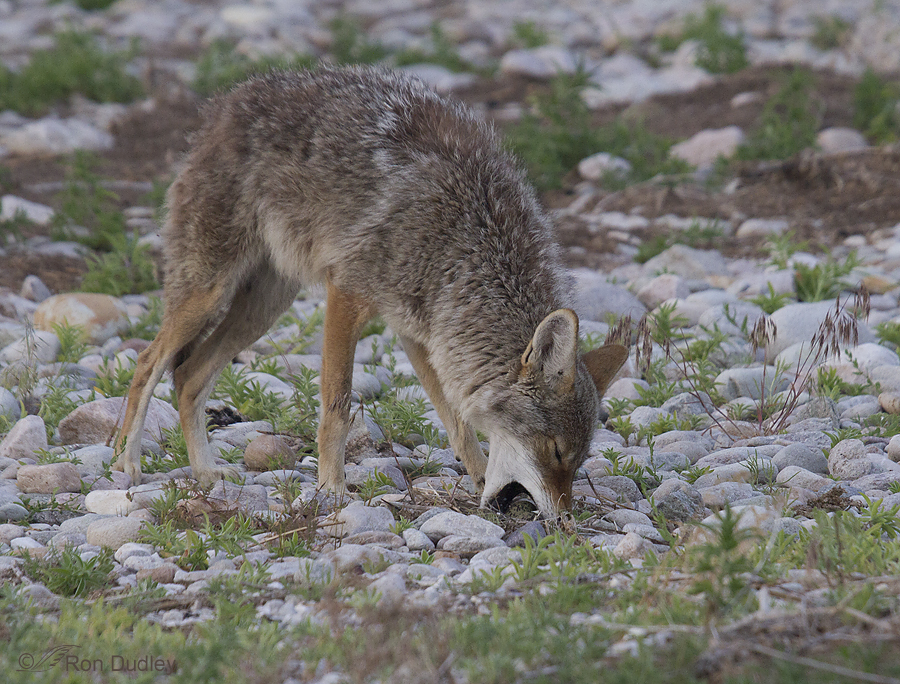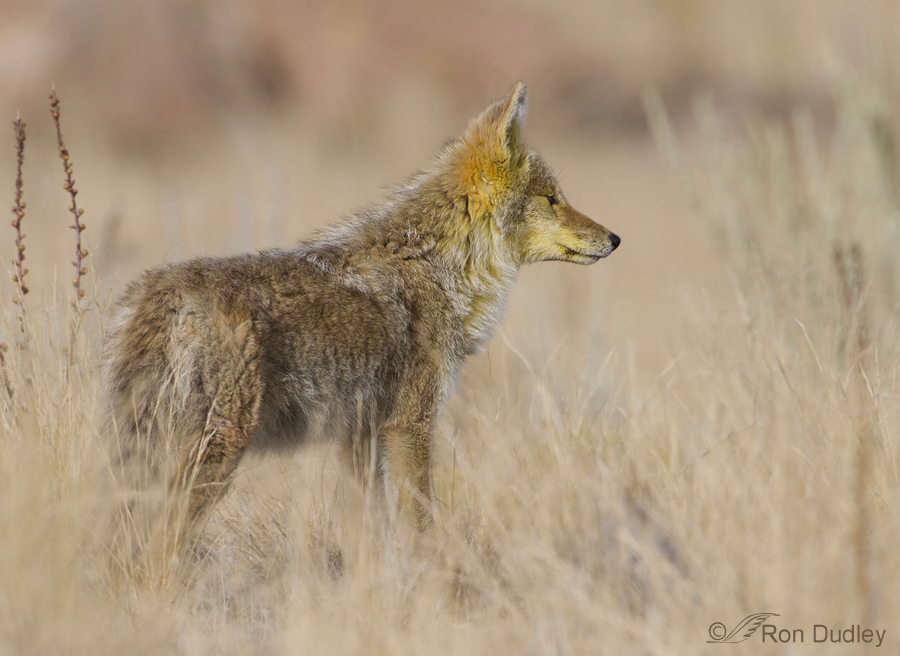Tag: canis latrans
A Montana Coyote On The Prowl

One afternoon on our latest Montana trip we decided to do a little “sploring” (as we call it) and investigate some country new to us so we spent several hours cruising the back roads on the south side of the Centennial Mountains. We found a beautiful mountain valley very close to the continental divide that provided a variety of habitats but few birds.
But it did give me my best photographic opportunity ever with a Montana coyote.
Some Interesting Coyote Behaviors

Late last week we encountered two coyotes walking east along the north side of the Antelope Island Causeway. One was a very light-colored adult and the other a slightly darker and smaller youngster. This summer has been a mighty survival struggle for the island’s coyotes – the vole populations crashed and the extreme heat and drought have taken their toll. These two actually seemed forlorn and destitute in both posture and demeanor as they walked the shore of the causeway. But they did show me several interesting behaviors that I was able to photograph.
Coyotes Like Eggs For Breakfast Too

At 5:30 yesterday morning Mia and I almost decided to stay home rather than make the hour-long drive to Antelope Island because the area up north looked to be socked in with clouds (the “Farmington Curse” I’ve mentioned before) but after we picked up our traditional “shooting breakfast” (chocolate donuts) we chose to take our chances and go anyway – a choice I’m glad we made.
A Vole Makes A Coyote Pay a Price For Its Meal
Yesterday morning I witnessed quite the little drama on Antelope Island. Two of them, really. This post will attempt to document what I saw. I lost sharp focus on a couple of these shots and some of the action was far away but I hope the images I include here will give you a feeling for all the excitement that unfolded. Going north on the ranch road we spotted four coyotes. Three of them crossed the road and walked slowly west while one of them left the area. At first I didn’t think they were in hunting mode, rather that they had a destination in mind. But this one detected a vole under the 6″ deep snow. From its body language it was obvious that it was able to hear the vole, even through all that snow. I’ve deliberately cropped this image to include the second coyote in the background. Notice in this shot, and the next two, that the background coyote is intensely watching something in front of and above it (there’s a relatively high mountain in that direction). Coyote #1 begins a pounce toward the source of the sound. The next image in the burst. It lands in the snow but apparently missed the vole. It stopped to listen again for a few seconds then pounced one more time. With its nose buried, it pushed through the snow like a snowplow for several feet. I believe that it was following the scent of the…
A Couple Of Intereresting Coyote Hunting Techniques
New Year’s morning on Antelope Island was a cloudy, low-light affair. It turned mostly sunny as we left for home in late morning and on the causeway we passed flocks of birders on their way to the island for their first day of birding in the New Year. I couldn’t help but notice the irony – us photographers who needed good light didn’t get any and the birders who don’t, did… But despite the low light I was able to photograph two coyote hunting techniques that I thought were interesting. 1/800, f/8, ISO 500, 100-400 @ 150 mm, natural light This coyote was on the edge of a large hill overlooking the frozen shoreline of the Great Salt Lake far below. I was very close to the animal but it was so intent on scanning the marshy area below for prey that it simply ignored me. At one point it stood on its hind legs with its front legs on a large, snow-covered boulder to give it an even more elevated view of the hunting grounds down below. I hoped that it would look back at me but it never did, though I think this pose, with just enough of the muzzle in view to show the direction the coyote was looking, well illustrates the hunting behavior. I was pleasantly surprised with one element of this photo. I was much too close to this coyote to use my 500mm lens so I had grabbed my other 7D with the 100-400 attached and backed the zoom down to 150mm. …
Indecisive Coyote With A Duck
Coyotes sometimes prowl the causeway to Antelope Island early in the morning. While they’ll certainly take the occasional vole they may come across, voles aren’t really their intended quarry. There are far more voles on the island than there are along the causeway. Coyotes come onto the causeway to scavenge. 1/2500, f/5.6, ISO 640, 500 f/4, not baited During winter there are many ducks along the causeway and occasionally one of them dies – an easy meal for a coyote. But most often these coyotes are after falcon leftovers. Peregrine Falcons and Prairie falcons often hunt the causeway and most ducks are too large for either species to completely consume, so there’s nearly always leftovers. Three days ago I found this coyote with a duck. The bird appeared to be frozen so I suspect it was carrion. Here, the coyote couldn’t decide which way to go with its meal – left or right, because the causeway is narrow and the animal is confined by the lake in the back and the road in front, which gave me an indecisive posture that I like (despite the side light). Ron
Baiting Coyotes On Antelope Island
I’m of the strong opinion that baiting wild animals of any kind for photographic purposes (or most any other purpose, with very few exceptions) is a despicable practice. It often puts the critter at risk in a variety of different ways and no photo is worth that. I’ve railed against baiting before on this blog so I won’t go into all the details once again here. But this morning I saw another example of why I despise this practice so much. The weather has been dreary and overcast for so long that I haven’t been out photographing for a while, but this morning we decided to head for Antelope Island just to get “out there” and ease our cabin fever a little, despite the clouds. As we came around a small curve on the island we noticed this coyote in the middle of the road. I could hardly believe it when I saw that it was feeding on dog food that someone had obviously spread down the center of the road in an attempt to lure coyotes up close and into an area where they wouldn’t be obscured by vegetation. And it worked! Even as close as we were, the coyote was intent on eating all of the dog food before it left the area. After taking a few documentary photos I drove up to the spot and then we picked up the kibbels and threw them away from the road (we probably should have taken them with us but I didn’t think of it at the time). We then reported what we saw…
Perched Coyotes
A perch (when it’s not a fish) is defined as “a roost for a bird” or “a prominent resting place”. Most of the perched critters I photograph have feathers, but not all of them. Many mammals like to perch up high on rocks, small hills or other natural or man-made structures in order to have a better view of their surroundings. In the case of predators, like coyotes, they often do so while looking for prey. Some small mammals (prairie dogs and ground squirrels, for example) often elevate their position in order to watch for predators. 1/1000, f/6.3, ISO 640, 500 f/4, 1.4 tc Getting a clear, relatively unobstructed shot of a coyote can be very difficult because of the types of habitat they tend to prefer. But sometimes I don’t think it’s necessary to get them in the clear. This coyote was hunting voles just as the sun was coming up. It deliberately placed itself in the shade of the sunflowers to be less easily seen as it watched and listened for rodents. Even though only about half of the coyote is visible, I still like the shot because it shows behavior and I think the sunflowers add a nice touch. There’s just enough light in the right eye to make this work for me. 1/2500, f/7.1, ISO 500, 500 f/4, 1.4 tc But when the coyote alone is the primary subject of the image, a relatively clear view of the entire animal is often preferred. That’s when the photographer can take advantage of the…
Coyotes Grazing On Grass
Please don’t expect great photography with this post. My purpose here is simply to document an interesting behavior. I’ve spent a lot of time over the years observing coyotes and I’ve seen them eat a variety of rodents (especially voles), birds and carrion but yesterday on Antelope Island I observed something new – grazing coyotes! I found a group of four of them on a steep hillside next to the road and they were very definitely eating grass. I’ll simply let these images speak for themselves. This was the only half-way decent image I was able to get with my 500mm that included all four coyotes. I guess the thought of coyotes eating grass is just something I’d never considered before but I shouldn’t have been surprised. Most domestic dog owners are well aware that their pets occasionally eat grass. Studies have shown that grass appears in 14 – 43% of all wolf scat in North America and grass in coyote and fox scat is so common as to be unremarkable. I watched as three of these four coyotes consumed grass and I suspect the fourth one was doing the same but it was mostly hidden behind sagebrush so I couldn’t be sure. There is just something so very incongruous about a group of canine carnivores slowly moving across a hillside while grazing on grass, like a herd of bison or elk. I thought it was an interesting behavioral display. Ron
Smiling Coyote
I see a fair number of coyotes in my travels but it’s fairly unusual for me to get one relatively unobstructed and up close – much less in good light. Less than two weeks ago this one cooperated in all three arenas. 1/800, f/6.3, ISO 640, 500 f/4, 1.4 tc And I just love it when they “smile” at me. Ron
A Banner Year For Coyotes On Antelope Island
If you think this coyote looks befuddled, you’re right. 1/1250, f/7.1/, ISO 400, 100-400 @115mm As it crossed the road right in front of me (about two weeks ago) it suddenly stopped in complete bewilderment because it could feel something on the left side of its neck, but when it turned to investigate the young coyote apparently couldn’t see what it was because the object was too close to its head and it was hidden in the crease of the neck. 1/1250, f/7.1/, ISO 400, 100-400 @115mm The offending object was a clump of grass which I could finally see when the coyote was able to nudge the bottom of the clump with its jaw and push it up where it was visible. 1/1650, f/7.1/, ISO 400, 100-400 @115mm The youngster finally got the grass clump pulled away from its fur, held it for a few moments in triumph and then unceremoniously dropped it and continued across the road… 1/800, f/6.3/, ISO 400, 100-400 @180mm where it captured a vole in less than two minutes. 1/640, f/5.6/, ISO 640, 500 f/4, 1.4 tc About a week ago I found this coyote staring at me in the early morning light. I love this warm light in the grassy setting. To me it almost looks like the coyote is smiling at me. 1/640, f/7.1/, ISO 640, 500 f/4, 1.4 tc And on the same morning, about 20 minutes later, another coyote crossed the road in front of me and proceeded to…
Antelope Island – A Smorgasbord For Coyotes
A lot of folks don’t like coyotes but I’m in a different camp. I have great admiration for their adaptability, hunting skills, intelligence and communication abilities. Over the past few years I’ve had many opportunities to observe their behaviors on Antelope Island which has made me an even bigger fan of this amazing canid. To watch a coyote hunt is a fascinating experience. This post is meant as a documentation of the opportunistic feeding tendencies of the species rather than as a showcase for technically perfect photos. Getting clear shots of any mammal on the ground (as opposed to perched or flying birds) is a rarity because of all of the grasses, sunflowers, sagebrush, rabbitbrush and moth mullein the photographer has to shoot through on the island. So there’s lots of “stuff” in front of the coyote in some of these shots and a couple of them are sizeable crops but I think their prey tendencies are documented reasonably well by the images. 1/2000, f/7.1, ISO 500, 500 f/4, 1.4 tc Coyotes eat a lot of voles – prodigious numbers of them in fact. I’ve seen a single animal catch and consume 4-5 voles in the same area within just a few minutes and I’ve seen it several times. 1/1000, f/6.3, ISO 500, 500 f/4, 1.4 tc But they’ll also take birds when they can catch them. This coyote was returning from the lake shoreline with an unusual prize – some kind of waterfowl. From the position of the leg attachment at the back of the body I’d guess…
A Tragedy For A Coyote On Antelope Island
I’ve always thought that nature photographers are some of the luckiest folks on the planet because we get to spend so much time in the natural world that we love and we see some of the most exhilirating sights and wonderous events that nature has to offer. But occasionally there’s a dark side. Yesterday was a difficult day in the field for me on Antelope Island. Be forewarned that the photos are of documentary quality only and that at least one of them may be difficult for some to view. When we spotted this coyote hunting in the grass for voles it was successful almost immediately and quickly swallowed its lunch. A few seconds later I noticed that it looked like it had caught another vole because I thought I could see the vole hanging out the left side of it’s mouth – the grasses were thick and it was difficult to tell. Then we spotted another coyote about a quarter mile behind this one and within a few seconds this animal also caught sight of the second coyote. When it did so there was an instantantaneous reaction – it put its ears down, its tail between its legs and started running through the grass like a bat out of hell to get away from the second coyote. I fired off a few shots as it ran but certainly didn’t get anything to be proud of. It wasn’t until I got home and processed the running shots that I knew something was terribly wrong. This…
A Howl of a Surprise
When you’re out in the field you just never know what you might see. Or hear. On an early morning this week I found this Male Northern Harrier on a trail sign. Since the perch was not a natural one I set up to try to get a take-off shot if he should lift off. 1/1600, f/6.3, ISO 500, 500 f/4, 1.4 tc As usual I was shooting from my pickup and in order to get in position for good light I had to park in the middle of the lightly used road. In such cases I always roll down the window on the passenger side so that I can hear any vehicle that might approach so I can get out of their way (it’s very easy to not see an approaching vehicle while concentrating on a bird through the camera’s viewfinder). Having that window down made a big difference to how I reacted to what happened next. 1/1600, f/5.6, ISO 500, 500 f/4, 1.4 tc Suddenly there was a piercing howl that was so loud it sounded like it was coming from inside my truck! Seriously, I almost jumped out of my skin it startled me so much. It was this coyote, hidden in the grasses. It was only about 75′ away from me and with three of the four windows down the clamor was tremendous. Coyotes often howl as loudly as 105 decibels and believe me that’s a very impressive din at this close range – especially when it’s unexpected. At first I could only see the…


